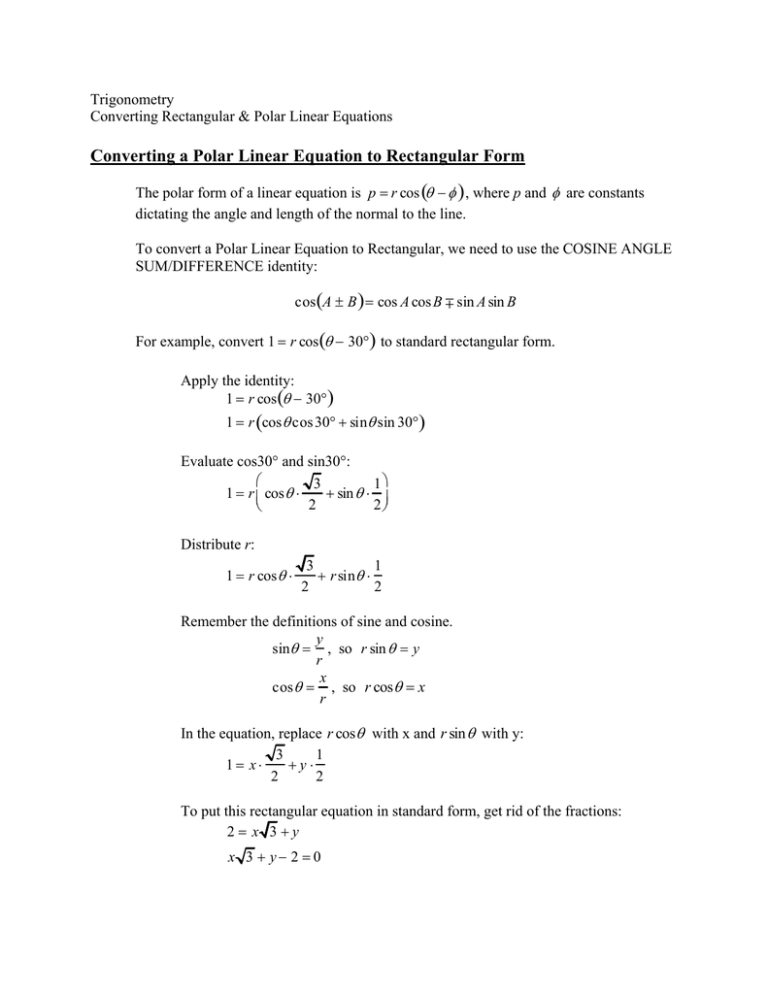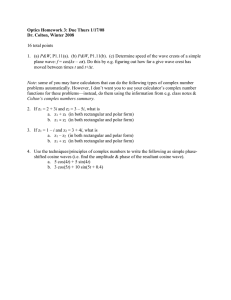Converting a Polar Linear Equation to Rectangular Form
advertisement

Trigonometry Converting Rectangular & Polar Linear Equations Converting a Polar Linear Equation to Rectangular Form The polar form of a linear equation is p = r cos (θ − φ ) , where p and φ are constants dictating the angle and length of the normal to the line. To convert a Polar Linear Equation to Rectangular, we need to use the COSINE ANGLE SUM/DIFFERENCE identity: cos(A ± B ) = cos A cos B ∓ sin A sin B For example, convert 1 = r cos(θ − 30°) to standard rectangular form. Apply the identity: 1 = r cos(θ − 30°) 1 = r (cosθ cos 30° + sinθ sin 30°) Evaluate cos30° and sin30°: ⎛ 3 1⎞ 1 = r ⎜ cosθ ⋅ + sin θ ⋅ ⎟ 2 2⎠ ⎝ Distribute r: 1 = r cos θ ⋅ 3 1 + r sinθ ⋅ 2 2 Remember the definitions of sine and cosine. y sinθ = , so r sin θ = y r x cosθ = , so r cosθ = x r In the equation, replace r cosθ with x and r sin θ with y: 3 1 1= x⋅ +y⋅ 2 2 To put this rectangular equation in standard form, get rid of the fractions: 2= x 3+y x 3 + y− 2 = 0 Converting a Rectangular Linear Equation to Polar Form Example: Convert 2x + 3y -1 = 0 from rectangular form to polar form. 1. If the RECTANGULAR form is Ax + By + C = 0, divide each term by 2 2 A + B if C is negative or by − A 2 + B 2 if C is positive. In our equation, C is negative, so divide each term by the positive number 2 2 + 32 = 13 . 2x 3y 1 + − =0 13 13 13 2. The absolute value of the constant in this equation is p for the polar linear equation, so 1 13 p= = . 13 13 3. The coefficient of x in the equation represents cosφ and the coefficient of y represents B sin φ . Also, tan φ = . Use any of these to calculate φ . A ⎛ 2 ⎞ = 56.3° φ = cos−1 ⎜ ⎝ 13 ⎟⎠ ⎛ 3 ⎞ = 56.3° ⎝ 13 ⎟⎠ ⎛ 3⎞ φ = tan−1 ⎜ ⎟ = 56.3° ⎝ 2⎠ φ = sin−1 ⎜ Since φ is in quadrant 1 in this example, all three gave the same angle. If one or more of the ratios is negative then φ will be in another quadrant. 4. The polar form of the linear equation is 13 = r cos (θ − 56.3°) . 13 Another Example: Convert 3x – 4y + 5 = 0 from rectangular form to polar form. Since C is positive, divide each term by − A 2 + B 2 = − 32 + (−4)2 = −5 . 3x 4y 5 − + =0 −5 −5 −5 3x 4y − + −1 = 0 5 5 So in the polar equation, p = 1. Calculate φ . ⎛ 3⎞ 5 φ = cos−1 ⎜ − ⎟ = 126.9° ⎝ ⎠ ⎛ 4⎞ 5 ⎛ −4 ⎞ φ = tan−1 ⎜ ⎟ = −53.1° ⎝ 3⎠ φ = sin−1 ⎜ ⎟ = 53.1° ⎝ ⎠ Although all three of these angles are different, they all have the same reference angle. These are all principal solutions. Consider for each trig ratio which two quadrants provide the correct sign. ⎛ 3⎞ cos −1 ⎜ − ⎟ → Q 2 or Q3 ⎝ 5⎠ ⎛4⎞ φ = sin −1 ⎜ ⎟ → Q1or Q 2 ⎝5⎠ ⎛ −4 ⎞ ⎟ → Q 2 or Q 4 ⎝ 3 ⎠ φ = tan −1 ⎜ The only quadrant that fits for all three cases is quadrant 2. Thus φ = 126.9° . The polar form of the linear equation is 1 = r cos (θ − 126.9°) .


